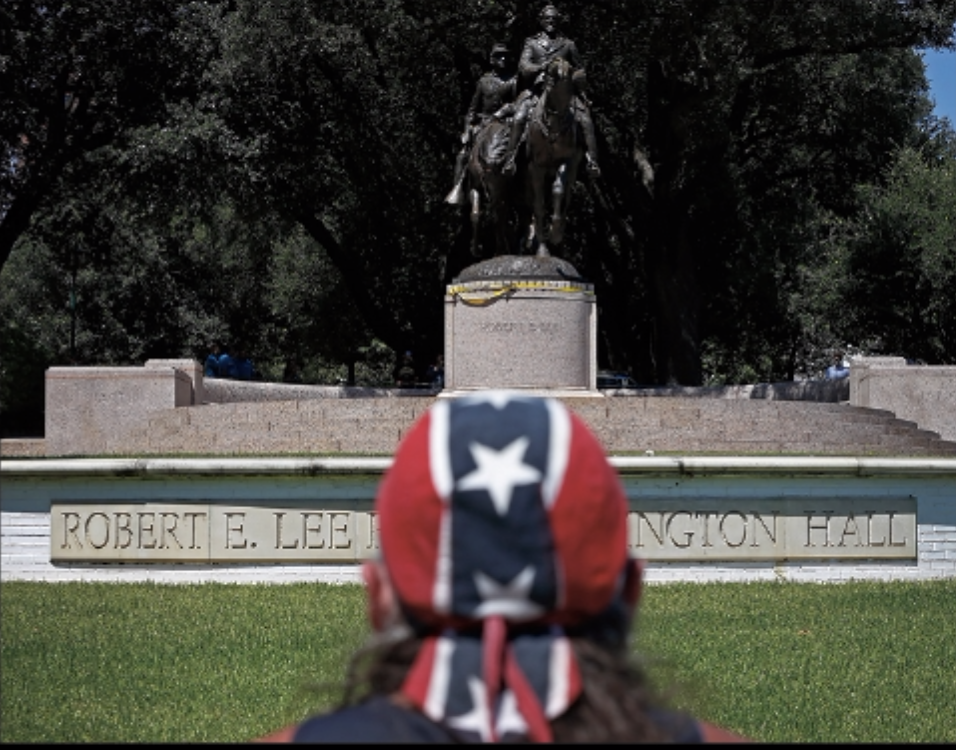“You can’t know where you are going until you know where you have been,” captions a black and white photograph of three bathrooms: one men’s, one women’s and one “colored” in Dr. Paul Hoelscher’s CHS classroom. This poster encapsulates what distinguishes humans from animals — the ability to recognize our history in order to make informed choices in the future.
For 105 years, Forest Park showcased two monuments memorializing this region’s dichotomy during the Civil War. Recently, in St. Louis, this special piece of history, a confederate memorial, was vandalized and then removed.
America must stop removing confederate monuments because by doing so we blot out important perspectives of the past, undermine the freedom of speech and distract from the real issues plaguing society.
Indeed, the Civil War was a pivotal moment for the United States. Soldiers chose allegiances based on geographical location. Americans often look at the Civil War as a fight between good and evil, yet in the end, after the country was reunited, 680 thousand Americans were dead.
These confederate monuments stand to inform Americans about the bloodiest war in our country’s history, and more importantly to recognize St. Louis’ role in the Civil War: sending 30,000 troops to the Confederacy. In addition, the monument, like many others, was erected in 1912 during the Jim Crow Era in the South. At this time the North allowed the suppression of blacks in the South to further political agendas.
Many seek to erase the Confederacy and the Jim Crow South from America’s story, but informed citizens of the twenty-first century must learn both sides of our history, positive and negative. Social activists and historians alike must learn the undoctored version of history.
Many modern issues can be traced to the Confederacy. To address these issues we are best served by understanding, not ignoring our past, no matter how disturbing it may be.
These monuments represent the social progress our country has made. We can not erase history. What is next? The demolition of Monticello or the dismantling of the Gateway Arch a.k.a. The Jefferson National Expansion Memorial because Thomas Jefferson owned slaves? Should we change the name of our city because Louis IX forced the Jewish people out of France in the thirteenth century?
We can not change the past. Nor should we cherry pick stories to create an inoffensive narrative. By destroying elements of our nation’s history, we are depriving the future generations of the opportunity to learn from society’s mistakes.
Moreover, confederate monuments represent another tenet of the United States — the freedom of speech. As citizens, it is most important that we protect the right to an unpopular opinion.
The idea that black people should not vote, that women should not go to college and that marriage should only be between a man and a woman were once prevailing opinions. Without the freedom of speech, these ideologies might have persisted.
The removal of Confederate monuments and symbols will not cure our social ills. The Confederate statues are not the cause of the racial education gap, wage disparities, unemployment, crime, drug use or other problems the black community faces. On the contrary, these campaigns to remove American history just distract from the core issues plaguing our society.
In conclusion, the removal of Confederate monuments erode America’s freedom of speech, do not make tangible improvements to the American condition and hinders our understanding of the past which clouds our visions of the future. We will not know where we are going because we will not know where we have been.


jonatrhon • Mar 9, 2020 at 10:11 am
i think the monuments should stay up becauseit is a part of the untied states history it not have been good but it is was it is and no matter what it wiull stay that there is no removing it from the past unless you went way back in time and changed it
Ron McCauley • Feb 26, 2020 at 8:25 pm
It is with a saddened heart I’m forced by my conscience to draft this letter of grave
concern, that being, the awareness and morality of the intent to rename school buildings and removing monuments of Military Veterans in a sense of right and wrong that urges one to act morally.
As a retired Military Veteran, I encourage City, County Governments, Public School Boards please do not change any Civil War Soldier’s name or remove any military monuments.
Know my letter to the Public, is not politically motivated but has a defender of American History. Our country from its European founding in the
sixteenth century, to present day, has had its share of dark, good, and great history.
I plead on behalf of our past, present and future United States Veterans… don’t remove or hide our past history. It is because of ALL of our Civil War Veterans, we became known as The United States of America, one Nation under God, Indivisible, with Liberty and Justice for ALL
Respectfully submitted,
Ronald E. McCauley – Retired
United States Air Force
Serving, Defending and Protecting our past, present and future history.
Ryan • Apr 18, 2023 at 4:54 pm
The Confederates were not fighting for the Union, not for the United States. They were fighting to uphold and spread slavery. They should not be honored on the same level as those who fought for the Union. Monuments to Confederate heroes are monuments to hate.
K man • Jan 22, 2020 at 4:31 pm
I believe that Confederate statues should be treated similar to Nazi swastikas and other symbols after WWII. These statues and memorials should be remembered, but not celebrated as they often are in southern states. The fact that groups like the Ku Klux Klan and other white supremacists are fighting to keep the statues erected and continue the “Lost Cause” ideology is enough reason alone to remove the statues and bring them to institutions of education so that the people looking upon the memorials are learning of our countries dark past, not to celebrate it.
Kannon Berning • Dec 13, 2019 at 12:55 pm
Um.. Why do we need statues to remember the past? Do you even hear yourself? I mean I could understand where you’re coming from if your’re someone who doesn’t have a simple education, because I mean it may have been sugar coated but every public school teaches about the history of our country. We learn about the mistakes our country’s founders made. And about slavery, the union, and the confederates. So why are these monuments so important if most people with a high school diploma know about the confederacy? I mean, yeah sure some of the Confederate generals are famous for their battle strategies, but that doesn’t make it right to put them on a pedestal for being a good racist. However, I do see how putting things like this in a museum good be beneficial to people who enjoy history. But then again, I can see how it would be offensive. My point is that these statues are kind of stupid.
Angela • Oct 14, 2019 at 8:31 am
I feel that if monuments are created without remembering the bad times than we won’t know what mistakes we did in the past. And if we don’t know our mistakes than we are going to repeat it.Those bad times in the past help strengthen our country – they show what we did wrong in the past and therefore we learn from it.
Dione L. • Mar 19, 2019 at 11:57 am
i think they should remove the monuments because they are in example of slaver and the bad times back then.
Alan Jones • May 4, 2018 at 12:26 pm
I find it an absolute nonsence to remove Confederate memorials from the UNITED STATES.
If we in Great Britain did a similar removal of our statues and monuments that represent oppression .
We would have to remove all traces of The Roman Empire/ The Viking Conquest/ The Norman Invasion.
These takeoverS of the land were Brutal and Slavery was perpetrated by ALL THESE INVADERS.
Should we therefore remove HADRIAN’S WALL/ VARIOUS VIKING SETTLEMENTS /THE TOWER OF LONDON.
The Removal is AN ASSAULT ON HISTORY, whether it by right or wrong. Educate people about the CIVIL WAR , DON’T DENIGH IT’S HAPPENING . We had 4 in No. Civil Wars — ALFRED OUSTED- THEVIKINGS / THE BARON’S REVOLT / THE WARS OF THE ROSES. /KING CHARLES & PARLIAMENT . Napoleon & Hitler DID NOT MANAGE TO ENSLAVE BRITANNIA!!!!
Yours
Alan Jones